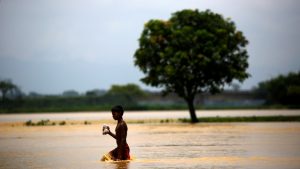
Timeline:
1996: February: Maoist Rebellion Begins, civil war ensues
2006: November: Civil War ends leaving 20,000 people dead and more displaced.
2008: May: Nepal becomes a republic
2015: 25 April: Earthquake kills thousands of people and causes widespread devastation
2014: November: Nepal and India decide to build huge dam on Arun River in Nepal to help mitigate energy shortages (this is symbolic of several controversial development projects)
2016: February: Nepal Submits its NDC for the Paris Agreement
2017: June to August: Monsoon Season: rainfall causes historic flooding
While all the events on this timeline are important, I think the damaged caused by this year’s monsoons is going to be particularly devastating for the current population. The monsoon season this year lead to historic flooding in Nepal, India, and Bangladesh. The communities in these countries are dependent on the monsoon season to replenish the rivers and a monsoon season with below average rainfall can have disastrous consequences. However, they are facing the opposite problem this year with historic flooding. In Nepal over a hundred people have died and hundreds of thousands of people have been displaced, causing major threats to their security.
One of the most important long-term impacts of the flooding is the effect on farming because a huge portion of the country depends on agriculture. The floods have washed away huge amounts of farmland which is going to lead to widespread food insecurity, especially for subsistence farmers. The flooding is also leaving people without a source of clean drinking water, which among other things, leads to the spread of disease.
The spread of disease is a huge concern in the countries affected by flooding. Diseases like cholera and typhoid are commonly contracted through consuming contaminated water and outbreaks of malaria are common after floods. Displacement camps are also a concern because disease tends to spread faster when so many people must live so close together.
Many people living in displaced persons camps will have nothing to return to when the floods recede, making them exceedingly vulnerable in the long term. Additionally, landslides triggered by the flooding have destroyed infrastructure in some places, making it difficult for many communities to receive aid. There have also been questions raised about the impact of dams on the flooding and how future projects could impact the monsoon season.
This flooding has had a huge impact on the security of Nepal. The monsoons have washed away people’s belongings and homes as well as their main sources of food. People are left without food, clean water, and shelter, all things that are essential to their security. The loss of farmland is going to be particularly devastating, given the number of people in the country who depend on agriculture.
Bibliography
Gettleman, Jeffrey. “More Than 1,000 Died in South Asia Floods This Summer.” New York Times. 29 August, 2017. https://www.nytimes.com/2017/08/29/world/asia/floods-south-asia-india-bangladesh-nepal-houston.html.
Gharib, Malaka. “Epic Floods Challenge Aid Workers On Opposite Sides of the World.” NPR. 29 August, 2017. http://www.npr.org/sections/goatsandsoda/2017/08/29/547002884/epic-floods-not-just-in-texas-are-a-challenge-for-aid-groups.
Humanitarian Health Action. “Flooding and communicable diseases fact sheet.” World Health Organization. http://www.who.int/hac/techguidance/ems/flood_cds/en/.
No Author. “Millions affected as monsoon floods ravage Nepal, India.” Al Jazeera. 14 August, 2017. http://www.aljazeera.com/news/2017/08/floods-landslides-kill-dozens-nepal-india-170813132206327.html.
